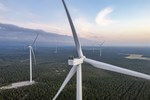News Release from American Clean Power Association (ACP)
Wind Industry Profile of
Wind power keeps the lights on and lowers costs
Yonk and Wardle are exactly right that the strongest energy system is comprised of a diversity of sources. An electricity grid drawing power from different types of generation protects consumers against both fuel price fluctuations and outages at specific plants. That helps keep the lights on and energy bills low. However, Yonk and Wardle miss that wind energy is a critical tool for increasing diversity and reliability.
In many instances, wind energy has proven critical to maintaining a cost-effective, reliable electric grid. During 2014’s Polar Vortex weather event, demand skyrocketed as buildings ran their furnaces at full output during the extreme cold. Supply was also reduced, as the frigid temperatures unexpectedly knocked many conventional power plants offline, in some cases due to fuel supply constraints. However, wind turbines kept turning, helping keep the lights on and energy prices in check. As a result, wind saved consumers across the Great Lakes and Mid-Atlantic regions over $1 billion in just two days.
Individual wind plants typically generate electricity over 90 percent of the time, a number that is increasing due to technological advances allowing wind turbines to reach stronger, steadier winds. This number increases even further when grid operators aggregate the output of all wind plants, and all sources of supply and demand, over large regions. Decreases in output at one wind plant are typically canceled out by increases at another plant. Moreover, any variability in the aggregate output of all wind plants is often canceled out by larger fluctuations in electricity demand and output deviations at conventional power plants.
This is no different from how conventional power plants are independently unreliable, but become reliable when their combined output is aggregated on a large power system, with all power plants backing up all other power plants. Coal, nuclear and natural gas plants don’t generate electricity 100 percent of the time either. They require maintenance and often experience outages from unforeseen events. When these things happen, other plants on the electric grid step in, illustrating the importance of a diversified energy mix.
Grid operators plan for wind’s contribution using the same tools and methods they use to plan for any other energy source. Adding wind energy to a system never increases the need for other power plants, but rather reduces it.
Yonk and Wardle attempt to attack wind by creating the strawman argument that the power system would face challenges if it were 100 percent powered by wind. However, the same is true for any energy source, as no source is 100 percent reliable or can cost-effectively provide all of the services needed to keep the lights on.
The electric grid needs three main services to ensure reliable energy delivery to consumers: energy, capacity, and flexibility. Energy can be thought of as the production of electricity, capacity is the ability to create power during high demand periods, and flexibility is the ability to change output to keep supply and demand in balance.
No single energy source excels at providing all three of these services. As a result, grid operators have always relied on a division of labor, with different energy sources providing the services they specialize in, to most cost-effectively run the power system. For example, sources like coal and nuclear typically don’t provide flexibility, and there can be cheaper ways of producing energy and capacity. Peaker gas plants are good sources of capacity and flexibility, but are not typically used to provide large amounts of energy due to their higher fuel cost.
Wind power’s greatest contribution to a reliable, diverse electricity mix is its ability to produce energy with no fuel cost or fuel price risk. Wind makes the power system more resilient and reduces fuel costs and risks for American families and businesses by making our energy portfolio more diverse, all while creating cleaner air.
This post originally appeared in The Hill.
- Source:
- AWEA Blog
- Link:
- www.aweablog.org/...
- Keywords:
- AWEA, Wind energy, costs, USA



























